G. LIONEL CARTER 1918-2008
Hobby Pioneer remembered for his many contributions to the hobby
|
G. LIONEL CARTER 1918-2008 Hobby Pioneer remembered for his many contributions to the hobby |
|
Hobby pioneer and one of the greatest baseball card collectors of all-time, G. Lionel Carter, passed away on August 28th at the age of 90. Lionel had been in and out of a nursing home for the past several months with long-standing breathing and circulation problems. I received the news two days later when I made one of my periodic calls to Lionel’s wife, Irma, to see how he was doing. I had visited Lionel in the nursing home in June, but was still in disbelief upon hearing the news. I had met with Lionel many times over the past seven years and remember him now as one of the nicest collectors I ever met. I had lost a pal. Lionel Carter was a gifted writer with vivid recollections. Fellow veteran collector, Irv Lerner of Philadelphia, aptly described Lionel Carter as "a first class gentleman." Carter wrote a wonderful tribute when Jefferson Burdick, the father of card collecting, died in 1963. He also wrote tributes for Buck Barker, Howard E. “Slim” Leheup, Harry Kenworthy and others, I will try my best to do the same for Lionel.
| |
|
Lionel soon was pursuing all the "new" cards; not easy if you were in a small town in the Midwest. He collected Goudeys, Diamond Stars and the various premiums throughout high school while also playing on the school baseball and basketball teams. Being a teenager and a bit older than the typical entry-level collector, Carter was particular about condition and kept his cards from getting dinged in kids’ games. He thought there must be other like-minded collectors out there and tried to find them. He subscribed to a stamp collector’s publication, Kaw Chief Stamp Journal of Lawrence, Kansas, and contacted the editor asking if he could write an article on collecting baseball cards. The article was published in their December 2, 1936 issue. I believe that Carter’s article was the first such article entirely about collecting baseball cards as a hobby. Unknown to Carter, a fellow card-enthusiast named Jefferson Burdick had just started writing pieces in December 1935 for Hobbies magazine dealing with cigarette cards and their organization. However Burdick’s early articles were not about baseball cards per se. Carter’s Kaw Chief Stamp Journal article came to the attention of Edward Golden of Norton Heights, Connecticut, who contacted Carter. They began trading cards like the Batter Ups. The higher series had not been distributed in Carter’s area but Golden had them. Golden led Carter to Jefferson Burdick’s new publication Card Collectors Bulletin. Carter quickly subscribed in 1938, got copies of the first five issues he had missed, and began a string of 70 years subscribing and contributing to hobby publications. |
Carter Serves in WWII
Lionel was particular about saying that he was drafted into World War II and served in the 112th U.S. Cavalry Regiment assigned to the South Pacific. Thankfully, the unit wound up leaving their horses elsewhere. Carter survived 27 months in combat and documented his experience by saving correspondence, news articles, and photos keeping them dry in water-proof bags throughout the war. He even continued to get Card Collector’s Bulletin while overseas. (They had added an apostrophe by then.) In order to make sure he didn’t lose one of the precious issues, he had a duplicate subscription sent to his parent’s house during the war.
With the war over, Carter started writing about his war experiences and immediately got back into collecting cards. Pioneer collector John Wagner contacted Carter and wanted to thank him for his service during the war by sending him a large box of tobacco cards. Lionel thanked him for the offer but refused it, preferring to first find cards to trade Wagner rather than taking them gratis. Carter also began writing more about the hobby. The Bulletin had been written almost exclusively by Burdick, but articles by Carter and some of the "other baseball boys," as Burdick described them, started to appear. Carter actively pursued the new issues: Leafs and Bowmans (PCLs in gem mint), the first Topps including the Connie Mack and Major League All Stars, team cards, blue backs and red backs. Each year Carter bought plenty of cards and began picking out the best-centered and clearest cards for his set collection and then trading or selling his duplicates.
Irma Carter
Carter moved to Chicago and was employed as a bank auditor at the North Shore National Bank of Chicago where he met his future wife, Irma. The always-bright, cheerful and patient Irma said that prior to the wedding Lionel gave her fair warning that he needed at least one evening per week to deal with his collecting interests. Irma accepted the arrangement and even accompanied Lionel on most of his out-of-town hobby-inspired trips. They traveled extensively and, not surprisingly, found themselves at places like Jefferson Burdick’s home in Syracuse, New York. Irma hosted several collectors at their home in the 1940s and 1950s including Jefferson Burdick, Buck Barker, Bob Solon, Howard E. "Slim" Leheup, and Charles Bray. Irma even urged Lionel at one time to pony up the additional money to buy the T206 Wagner from fellow collector, Preston Orem. Lionel thought the price too high though at $150 and took a pass; always a patient and thrifty collector. Jefferson Burdick agreed in a letter to Carter that $150 was a good three times "book," the book being Burdick’s own American Card Catalog. According to Lionel, Frank Nagy eventually bought the Wagner from Orem for $125.
Carter and Burdick
Burdick came by train from Syracuse to visit collectors in Chicago and specifically wanted to see Lionel Carter’s collection. The 1933(4) Lajoie eventually came Carter’s way directly from Jefferson Burdick, at no charge. Burdick described Carter as the "King of the Mounties" referring to his meticulous manner of placing cards in albums using corner mounts, in the pre-plastic era. In a 1961 letter to Carter, Burdick wrote: "In a few years a lot of us old timers will be gone and you will be senior collector and top authority." A few months before Burdick’s death "Jeff" Burdick wrote Carter one of the many long letters which he had sent over the years. It included: "Will be looking forward to writeups of the (Carter) trip. Almost as good as being there. Another unique Carter service. Don’t plan on me flying to Chicago. I’m still too shaky on the feet to roam very far. Have resumed work on the cards at the museum and hope to finish the job this Fall. Its an awful mess. Special regards to Irma, Jeff"
Collector Correspondence
Prior to the shows, collectors filled their wants by contacting fellow collectors. The usual method was my mail. If any cash had to exchange hands it might be included by using postage stamps in lieu thereof. The deals were not very pricey. Lionel Carter corresponded with hundreds of other collectors including: Burdick, Orem, Charles Bray, Bob Jasperson, Woody Gelman, Frank Nagy, Buck Barker, Harry Lilien, Ed Golden, Bob Solon, Frank Barning, Dan Even, Gavin Riley, E.C. Wharton-Tigar, Dr L. Kurzrok, Bill Haber, Elwood Scharf, Bill White, George Husby, Larry Fritsch, Bill Mastro, Don Steinbach, Harry Kenworthy, Dan Jaskula, Bert Sugar, Steve Vanco, Lew Lipset, Jack Smalling, Howard Leheup, John Rumierz, Jim Nowell, Gene DeNardo, Irv Lerner, Vic Witte, John Stirling, Wirt Gammon, Charles Brooks and George Vrechek. His correspondence with Buck Barker and Bob Jasperson spanned some 30 years.
Irv Lerner Shares His Recollections
Irv Lerner was the managing editor of the Who’s Who in Card Collecting that featured the Card Collectors Hall of Fame. Irv’s 1971 biography of Carter in the publication included: "Lionel Carter is perhaps one of the half-dozen best known collectors in the fraternity. Over the years his name has become synonymous with honesty, fair play and integrity." Irv was 18 years junior to Lionel Carter when he first contacted him in the late 1950s. Lerner remembered: "I sent him a letter. He didn’t know me from Adam. He sent a very nice letter in return. He said something like thank you for contacting me. I think I’m a little above your level of collecting at the moment, but here are some cards you can have." He enclosed a 1958 yellow letter variation and another difficult card seeking nothing in return. Lerner got to know Carter as "someone who was very helpful with other collectors. He treated people with candor but at the same time encouraged you to collect." Eventually Lerner and Carter became "the two nuts (in Lerner’s words) who wanted just the well-centered mint cards." They would ship back and forth 50 mint cards at a time over the next few years. (It wasn’t that Carter only collected mint cards. He would always try to improve on the condition of cards he had in a set, but would pick up a card he needed regardless of condition.) Carter helped supply information for the Card Collectors Hall of Fame biographies.
Frequently Published
Carter collected well into the late 1980s when the crush of new cards became overwhelming. He didn’t like the fact that card prices continued to escalate. He was never really interested in selling his collection. The money was unimportant, the cards were his passion, and he thought the high prices took some of the fun out of the hobby.
Lionel was a stickler for details and enjoyed writing with a dash of humor. Consequently his letters were frequently published by the Chicago Tribune and other papers, For example, he wrote letters to the Sporting News and the Baseball Hall of Fame objecting to what he noticed as irregularities in the Hall of Fame voting which resulted in a change in their voting rules. He followed the Cubs, Bears, University of Illinois teams, Bulls, Blackhawks, and White Soxs. He loved baseball trivia contests and had an annual "hot stove league" meeting with fellow fans. He organized reunions of his WWII army unit for over 50 years. He endured calls and letters from collectors seeking cards and researchers like Troy Kirk and me. He marched in the local 4th of July parade as often as possible wearing his army cavalry uniform, which still fit the always slender Carter. He was a fixture at the Levy Senior Center in Evanston. Just a few years ago, he pinched hit for a no-show speaker by discussing the Chicago Cubs in great detail.
Lionel Shared His Love of the Hobby
Lionel confided that he had suffered from small strokes and heart attacks. He apologized when he was unable to meet because of feeling weak. He would always make time though to talk about sports and collecting. He was a great admirer of Jefferson Burdick. I was a great admirer of Lionel Carter. After a visit to Lionel’s home he would often think of something that I might find of interest. He sent me 17 letters or packages with copies of letters or articles over the past seven years even though we only lived eight miles apart. I never asked him what he intended to do with the cards. I felt quite bad when burglars entered his home and, by pure chance, took a small but valuable portion of the collection. Fortunately, with the help of the police, Doug Allen of Mastro and others in the hobby, the stolen cards were returned to Carter intact. But the damage had been done. Lionel decided to sell.
Doug Allen of Mastro Auction
Once Lionel decided to sell his collection he called Doug Allen of Mastro and told him to take it all. Allen and his staff meticulously readied the collection for auction in 2007 and had the key cards graded and notated as being from the collection of Lionel Carter. When publicity was arranged to make people aware of the auctions, Carter told ABC News: "This was everything, and I said I would have these cards until I died, but now I guess I'll lose the cards first."
Like me, Doug Allen had also been planning a return visit to the Carters and was surprised by the news of Lionel’s passing. Allen continued to stay in touch with the Carters following the auctions. He was "honored to have the opportunity to know him and work with him." Allen added: "Lionel Carter was really an interesting man. I had a great appreciation for him and will never forget him." Allen felt that Carter was perhaps more eager to move on after selling his collection than people thought. Allen remembered that Carter said he had not really looked at the cards that much in recent years and that "everyone else is more excited than I am. He quickly veered over to how proud he was to have served during the war." His combat experiences showed that he was a very brave man. One of Allen’s last visits this summer was to talk to Lionel about the 60-year war book project which Allen now plans to publish for the Carters under the title Carter in the Cavalry. With a little coaxing, Lionel put on his old cavalry uniform shown here. He looked sharp.
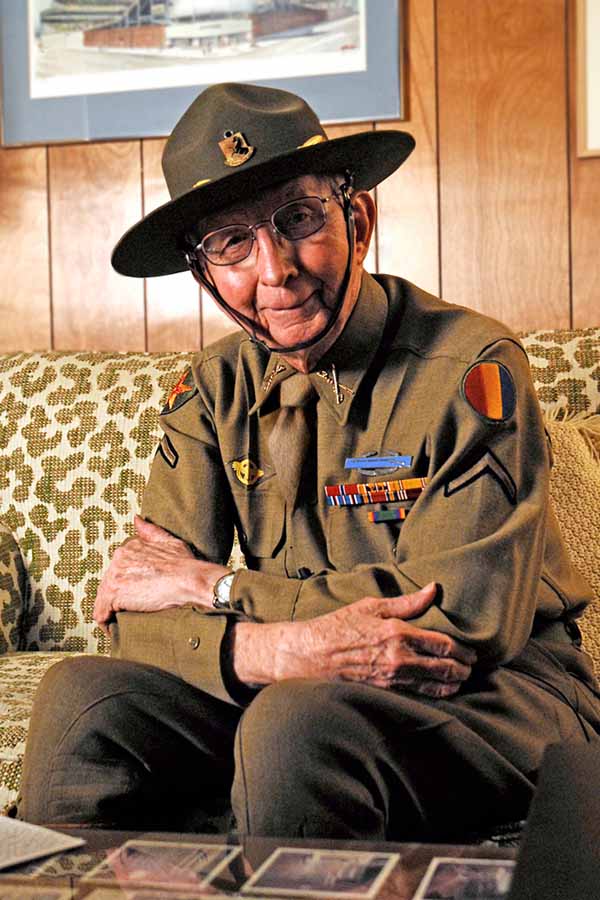
| ||
| Lionel in Cavalry uniform, 2008 (Photo by Mastro Auctions) | ||
Last Letter and Last Visit
The last letter I received from him was hand written because his trusty Smith Corona typewriter had finally bit the dust. I encouraged him to try a computer but he hesitated. The letter thanked me for my SCD article on Buck Barker and Lionel inserted several !!! which translated to high praise indeed. Lionel got a charge out of my pro-rating the modest writing fees with him to recognize his contribution to the stories. He made more in fees in this manner than he had ever received for his years of writing for hobby publications. Included in Lionel’s letter was a baseball card for me, a 1985 Topps card of pitcher Ken Schrom of the Twins. Lionel wrote: "Sending a baseball card the Mastro gang must have missed - you can stamp it from "the Famous Lionel Carter Collection" and (list) it for $150,000! Go Cubs!!! Lionel PS. They won’t beat anybody in the playoffs any way. Pitching Lilly on three days rest was a big mistake."
When I visited Lionel in the nursing home on June 12th, Irma had warned me that he might not be his old self. I found him to still have his interest in sports and collecting, still have an interest in other people, and still have his sense of humor and smile. We were glad to see each other. Before I left, a nurse took our picture which is included in this article. Lionel was a collector to admire, a sports fan first, an all-around good guy of the hobby. He will be missed by all who had the privilege of knowing G. Lionel Carter.
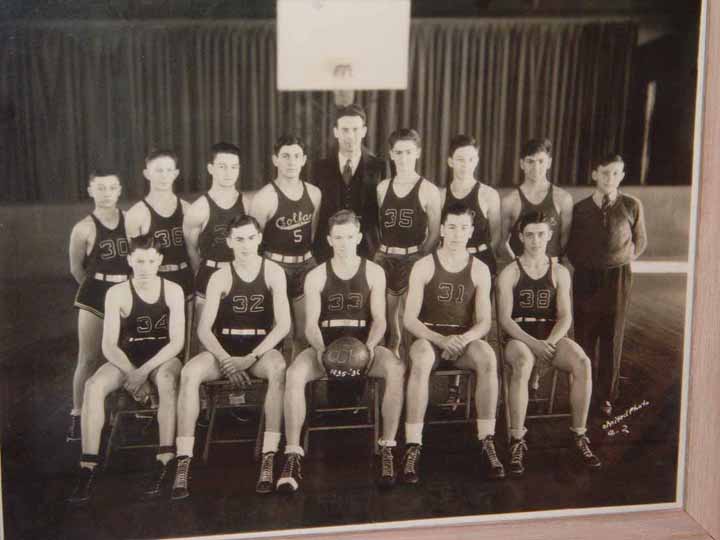
|
||
| Lionel Carter is number 36, second from left in back row high school team | ||
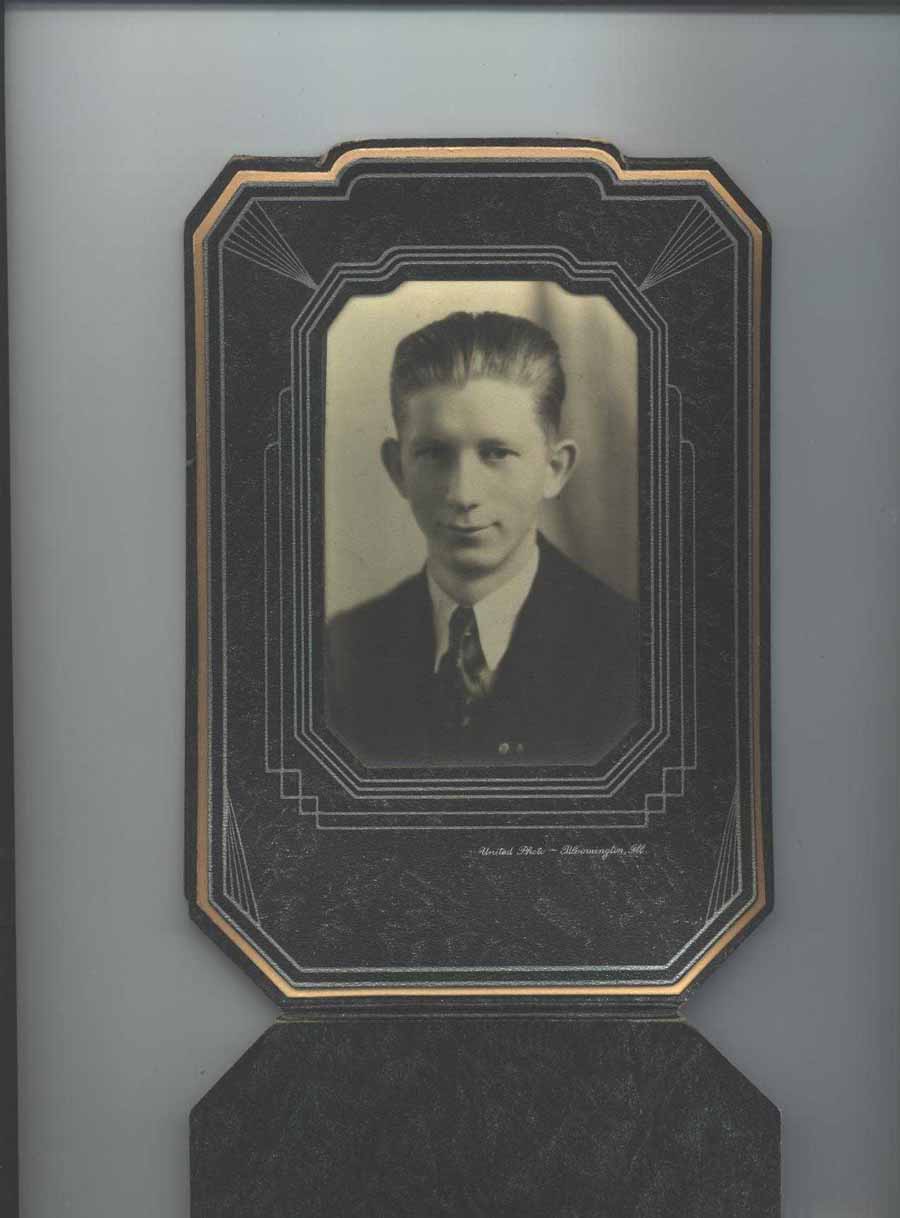
|
||
| Lionel Carter High School graduation photo, 1935 | ||
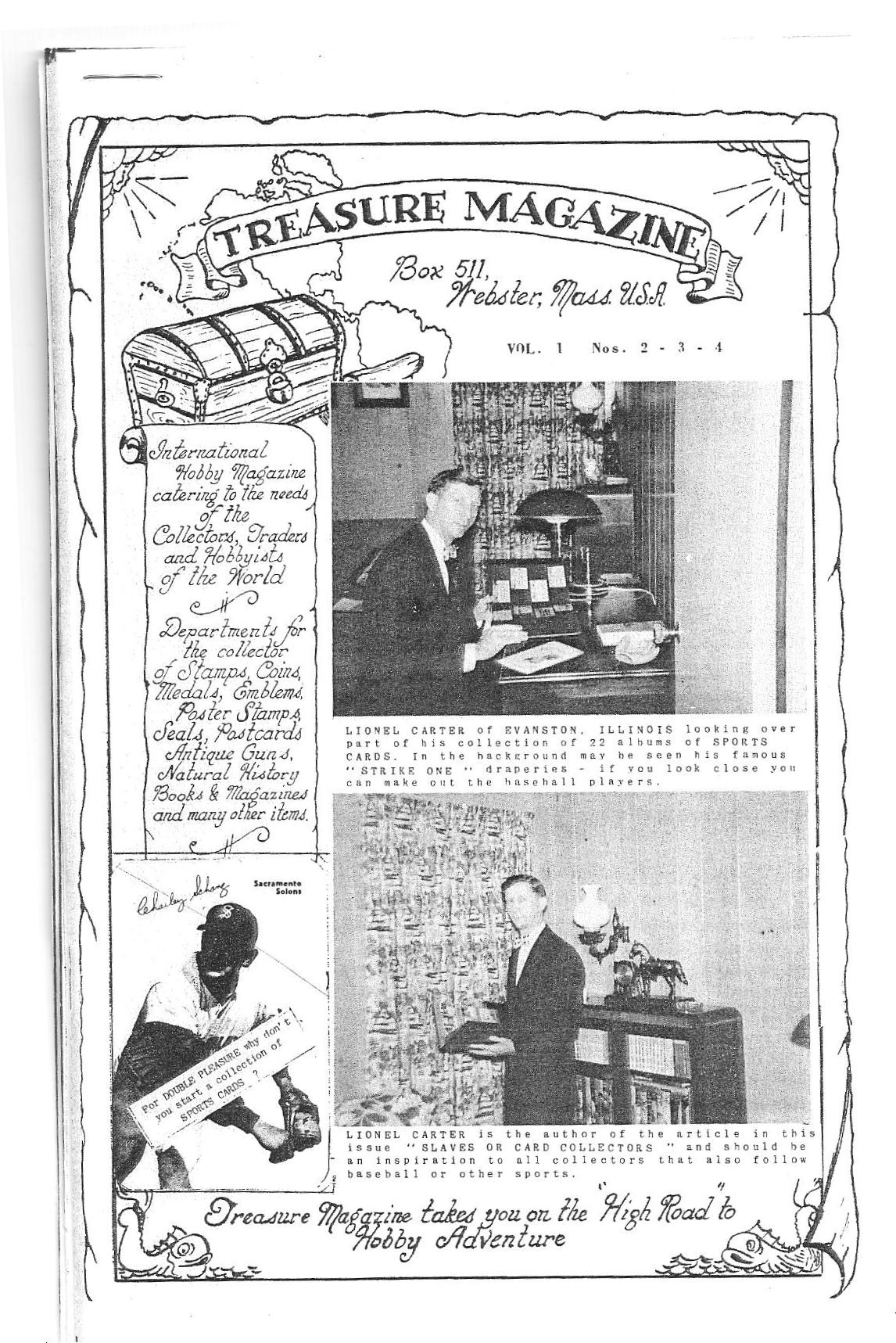
|
||
| Treasure Magazine article | ||

|
||
| A couple of Lionel's albums | ||
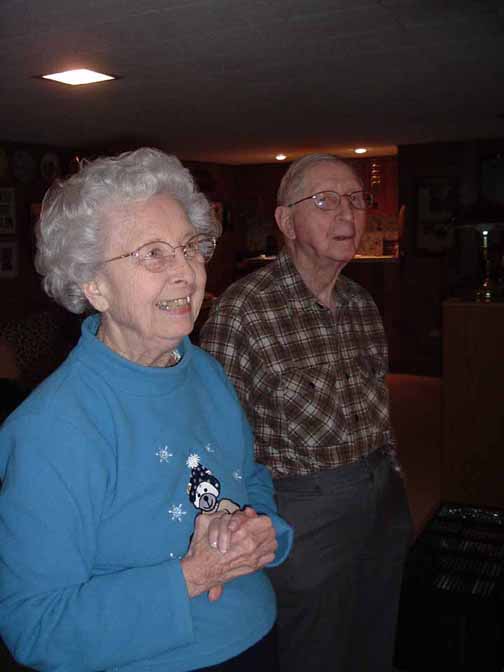
|
||
| Lionel and Irma, 2002 | ||
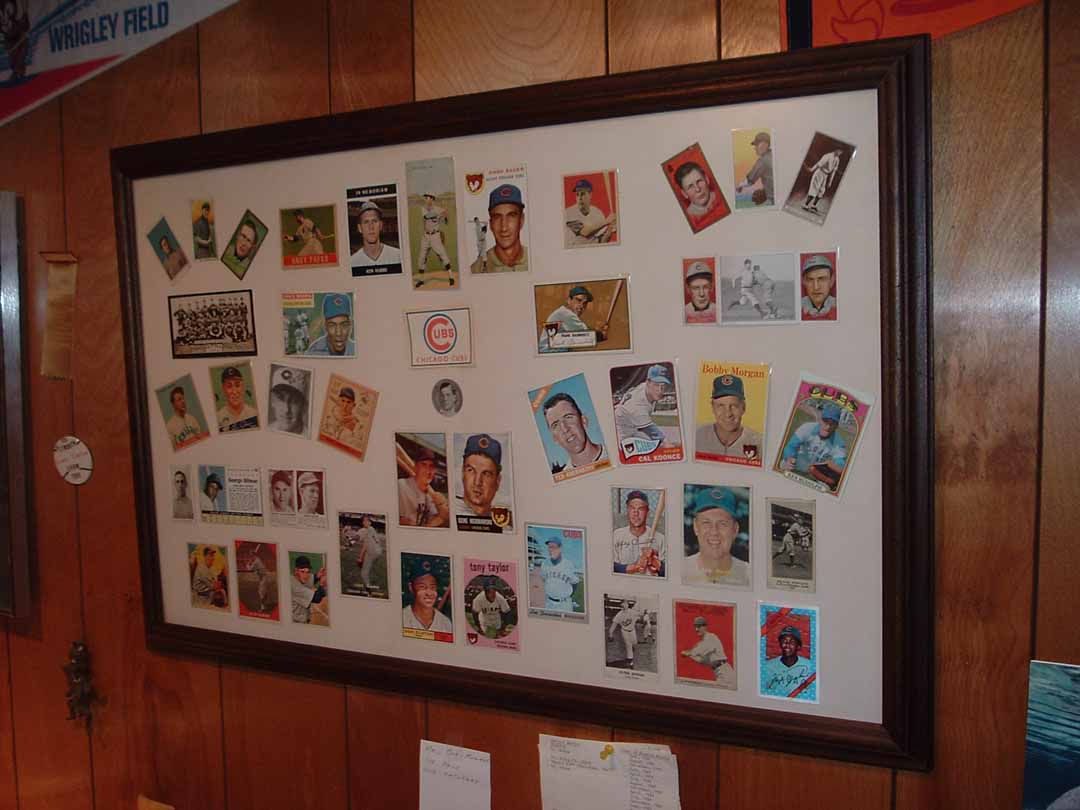
|
||
| Lionel's Cub display | ||
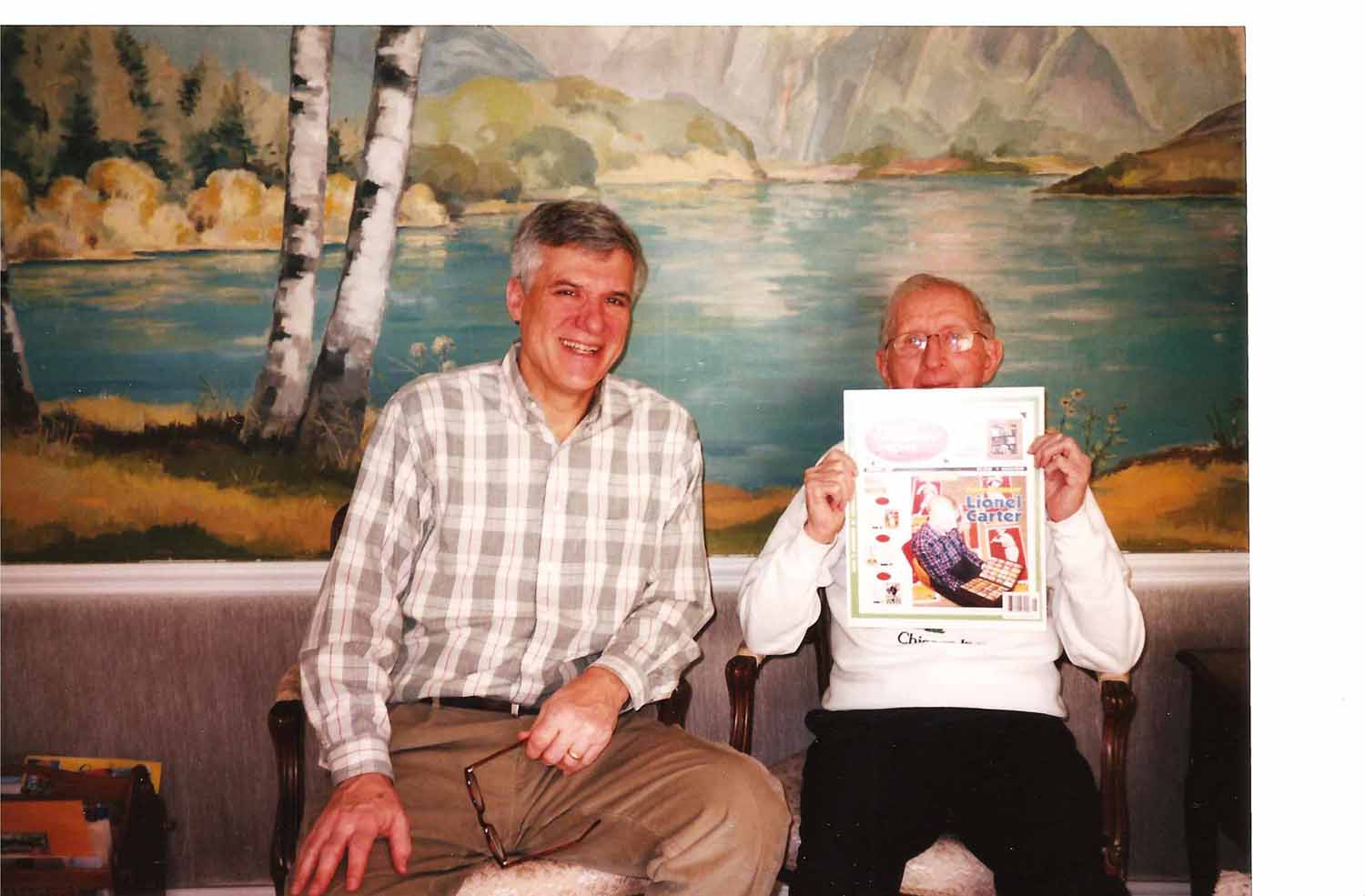
|
||
| George and Lionel, who displays a scan of himself | ||

|
||
| Lionel on the cover of SCD | ||
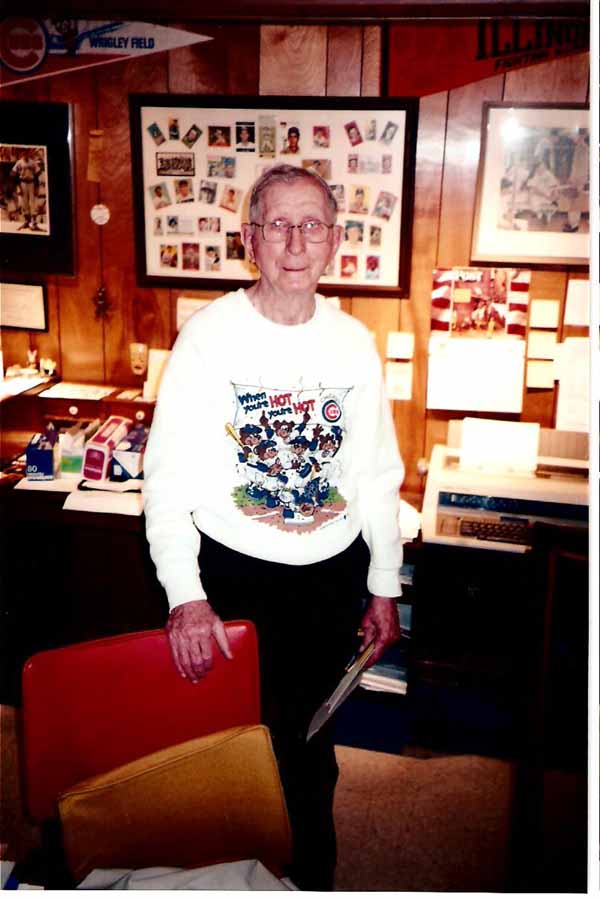
|
||
| Lionel always a natty dresser, sporting a Cubs theme shirt | ||
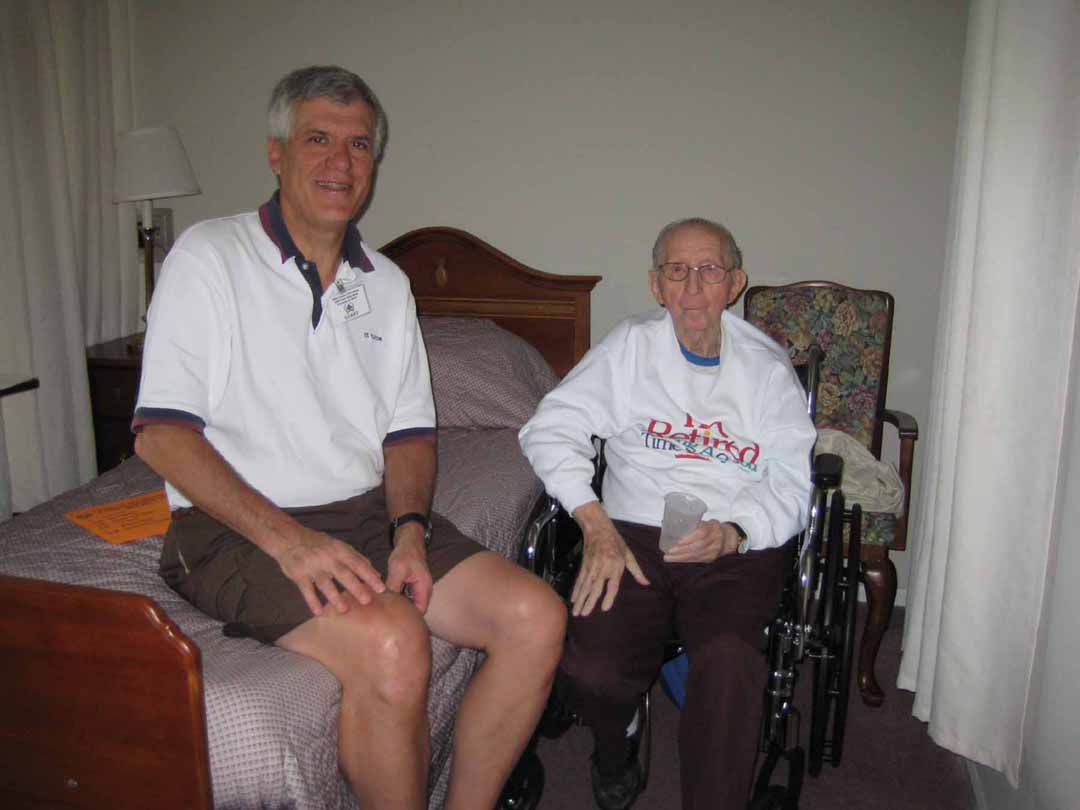
|
||
| George and Lionel, June 12, 2008 | ||
"A stick of gum and a baseball card for 1 cent," the clerk had said, and I had handed over my nickel for five.
I think the first card set purchased by a collector remains one of his favorite sets.
About flipping: Frayed edges and trimmed cards, those boys should have been thrown in jail.
Excerpt from Lionel Carter’s tribute to Jefferson Burdick: J.R. Burdick was quiet, unassuming, a man dedicated to a hobby for the sake of the hobby, not for any altruistic motive, a man whose honesty and integrity could not be questioned….The dedication of this man to a job and the determination to see it through can best be illustrated when one realizes that he lived until the last card in his collection was mounted. There will never be an equal to J.R. Burdick in our hobby as a man, as a collector, as an editor, as a writer, as a publisher, as an organizer.
What people don’t realize was that in the early days of the 1930’s, people didn’t just collect sports cards, but most serious collectors collected the various tobacco issues of presidents, Indians, trains, kings and queens, military uniforms etc. and looked down on sports cards with disdain. In fact, when Burdick decided to put out the American Card Catalog he came to see me in Chicago as he regarded me as a sports card expert!
When I returned to the states I would bid on sets of cigarette cards…won a set of mint T201s with a bid of $5. After being discharged in 1945, I would bid on sets of tobacco cards, compare the condition of the cards in my purchase with those in my collection, then put the worst copies back in the next sale. Often I’d sell them for more than I paid for my set! It was while doing this that I chanced upon a card of the ever rare ‘Plank, Phila. Americans.’I did lots of swapping. I was constantly mailing small packages of cards to other collectors, particularly with Eddie Golden and Harry Lilien in New York City. I’d mail cards to Harry every week and to Eddie every other week, and we’d stuff our letters and packages with clippings from local papers.
Most kids preferred the Goudey cards so that I ended up with several cigar boxes of DeLong which no one liked (Traded them off for cards I didn’t have later.)…But it’s a lonely hobby when you are the only one in it, and the only “dealers” were the candy store and drug store proprietors.
Collecting cards in those days was really fun, the cards weren’t worth much, so no one worried about the value, it was just a swap of card for card ordinarily.
I finally met my first collector face to face: Larry Brandt. We’d buy several boxes of each series as it was offered in the stores then we’d open all the individual packages (one card to one stick of gum for 1 cent in those days), heap the cards on the floor in a big pile and throw the wrappers and gum down the incinerator. We’d flip a coin to see who got to pick the first card, then we’d each pick a card in turn, selecting not the star players but the best centered cards regardless of the player.
Collectors were known as ‘hard to swap with’ or ‘easy to swap with.’ One of my favorite swappers was ‘Buck’ Barker of St. Louis, who was a real character and one of the best liked collectors. Buck would mail cards to me from my want list and I’d try to locate cards from his want list from other collectors’ duplicate lists, being careful not to add the cards he sent to my collection until we had agreed upon a swap to him in return. Invariably I would finally give up and send the cards he had sent me back to him, bringing my indebtedness to him down to zero for a few months until he came up with some more cards I needed….Buck would write all over the backs of his cards, even change the team names on the front of the cards…He was always changing his collection around by teams…came to Chicago and swapped. I gave Buck a list of second hand book stores…Buck went downtown and came back that evening with stacks of rare candy and gum cards of the period between 1910-1915!
O B C : A T r a d i t i o n o f E x c e l l e n c e S i n c e 1 9 9 1
Old Baseball Cards (OBC), copyright© 1991 - by OBC.
Unauthorized use of the material contained on this page is strictly prohibited.
This page was last updated on